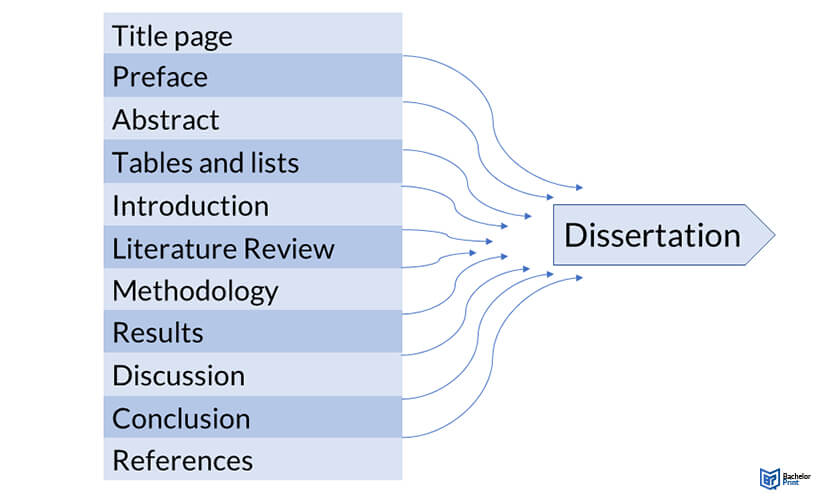
A dissertation (a.k.a. a thesis or final year project) is a long-form academic essay on a niche subject that requires original, primary research alongside an extensive discussion of existing topical secondary works. Your dissertation grade will usually weigh heavily (40%~70%) on your final award. Ideally, your dissertation needs to be your masterpiece.
Definition: Dissertation overview
- The overwhelming majority of undergraduate and postgraduate taught courses require the submission of a dissertation to pass.
- A dissertation will take ca. 6~18 months to complete, usually covering ca. 5000-15,000 words. You can expect to receive your assignment and deadline during the last third of your timetable.
- What you study (within reason) is up to you. Pre-made questions and projects might also be available if sources and inspiration are lacking.
- Your assigned dissertation supervisor will provide valuable input, insight, and advice on structure and substance. Make sure to update them regularly.
- Your deadline will likely coincide with the end of your last academic year. Extensions may be allowed to account for personal setbacks, travel, or complex research projects.
Dissertation research plans are kept deliberately formulaic. Every dissertation develops as so:
-
Initial research
Potential areas of interest are shortlisted. -
Establishing a question
What exactly will the dissertation ask? -
Initial proposal
Viability testing and hypothesis fine-tuning. -
Source analysis
Collection, exploration, and discussion of sources. -
Writing
A dissertation overview begins to form. -
Development
Content, polish, detail, and nuance. -
Editing
Trimming, referencing, and error checking. -
Submission
The dissertation is marked.
There are also slight differences in how British and US academia use the word dissertation. Remember that:
| British universities (UK) | American universities (US) |
| A dissertation is the final written assignment for a Bachelor's or Master's degree. The text of a PhD is a thesis. | The term "dissertation" is used to refer to a written PhD. |
Dissertation overview: Research proposal
Before you start with the dissertation overview, write a draft dissertation research proposal, refine it, and get it approved by your supervisor(s).
Your draft will broadly cover why you want to research your topic, your plan or methodology, and why your dissertation would benefit academia.
Academic discussion at this stage is critical. Considering constructive advice and ideas from your tutors and field experts helps highlight productive questions.
Better planning usually results in a better end mark.
In practice, your research proposal will be a short paper (ca. 500~2000 words) explaining your ambitions. It contains:
- Introduction: A dissertation overview.
- Background review: A guide to your area of study.
- Literature review: An overview of Existing Sources.
- Methodology: Your main question(s) and research plan.
- Implications: How your research will contribute.
- Conclusion: A summary recap.
Dissertation overview: The structure
Now you can start filling out the skeletal structure of your dissertation overview. Depending on your style, you may find it productive to create extensive notes before ordering them.
Your research will segment by topic, area, purpose, and theme. Your structure will also vary to match your discipline.
- Dissertations in the humanities often read like lengthy essays, building to a central, final argument.
- Dissertations in the sciences tend to divide mechanically. Methodology, experiments, results, and implications place into different, unique chapters.

Dissertation overview: Title page
Every dissertation overview starts with a title page. The front cover provides vital information about who you are and what you’re about.
A dissertation title page includes:
- Your full name
- Your student and submission numbers (If relevant)
- Your course and projected award (e.g., BSc Hons. Biology)
- A full dissertation title
- Your university (or awarding institution)
- Your department and supervisor
- A university logo
- Your date of final submission
Your dissertation title should always be placed at the top.
Dissertation overview: Preface
The preface of a dissertation overview is a special place to acknowledge crucial institutions, individuals, or experts who helped you. You can also dedicate the work to a loved one.
You should always politely acknowledge your supervisor, your personal tutor, and any labs, libraries, or archives used extensively.
Dissertation overview: Abstract
The abstract is a ca. 150~500-word paragraph dissertation overview briefly summarizing your topic, questions, methodology, and conclusions. It reads as a dissertation overview and a formal blurb for your work that advertises it to new readers. An effective abstract requires a complete and flowing thesis to draw on. Writing your abstract should be your absolute last task.
- ✓ 3D live preview of your individual configuration
- ✓ Free express delivery for every single purchase
- ✓ Top-notch bindings with customised embossing

Dissertation overview: Tables and lists
Good direction, collation, and indexing help keep your dissertation easy to read, reference, and check for errors. An effective dissertation overview consists of the outline of chapters, inserts, and technical terms.
Dissertation overview: Table of contents
The table of contents tells readers which numbered pages link to which segments. It always appears before the main text. This section helps simplifying your dissertation overview.
Your contents table should cover all chapter headings, major subheadings, and other exceptional points of interest. Page numbers should always follow each entry.
Avoid citing every individual subheading, paragraph, or change of topic. Careful curation of milestones is best.
You can easily use Microsoft Word to autogenerate a table of contents. Remember to activate automatic page numbering.
List of Figures and Tables
Likewise, you should cite all relevant figures, tables, and illustrations here. A table list is optional but highly advisable for a dissertation overview.
Write your items in a numbered list in order of appearance. Again, Microsoft Word can autogenerate this via the Insert Caption feature.
List of Abbreviations
Abbreviations help save space in a packed manuscript. However, unexplained, obscure acronyms can confound even experienced readers.
If your dissertation references unusual, new, or technical abbreviations, include an alphabetical guide that explains their exact meanings. Avoid including commonplace abbreviations (e.g. a.k.a.).
Glossary
You can also add an explanatory glossary of complex technical names and terms to your dissertation overview. Scientific dissertations may find some (optional) exposition particularly useful.
Again, order your entries by first alphabetical initial and avoid common words. Term descriptions should be 1-3 sentences long.
Dissertation overview: Introduction
Your introduction gives a first glance at your topic, purpose, and impact. Think of it as an expanded abstract. Stay clear, relevant, and assertive – this is your first chance to hook the reader.
Your introduction is also a great chance to make the relevant initial points needed to set up discussion, exploration, and argument. In the dissertation overview, you should:
- Clearly state your research question and objectives
- Set your focus and topical limits
- Detail all necessary background information and context
- Argue why your dissertation is relevant
- Outline your broad structure and methodology
Dissertation overview: Literature review
A topical literature review briefly tells the reader about existing material, comments on relevance, and demonstrates gaps in our collective knowledge.
Your literature review often forms the backbone of your broader theoretical framework in the dissertation overview. Primary, secondary, and meta sources (e.g. commentaries) count as literature.
| Discuss: | Avoid: |
| • Source credibility • Analysis of each source • Any obvious shortcomings (e.g. Bias, length, outdated methodologies) • Recurring patterns and themes • How you will build on your sources |
• Simply repeating your source content (as is) • Taking complex, improbable, or controversial sources at face value • Leaving connections unexamined • Not setting clear study objectives • Missing out major works |
Dissertation overview: Methodology
In the dissertation overview, your methodology section describes the methods you used to collect and process your research data. Stating your methodology keeps your research credible, verifiable, and transparent.
Your methodology section should cover how and why you made your choices (e.g. longitudinal-isolated, qualitative-quantitative), your collection methods, and how, where, and when you collected your primary data. Make a solid case for why this was the best technical approach available and address ethical concerns.
You should expect to write a far lengthier methodology for dissertations in the sciences over literary subjects (e.g. History).
Dissertation overview: Results
The results in the dissertation overview is where you list what you (objectively) discovered. Discuss all results – even if the data didn’t match your expectations.
Tables, graphics, and prose summaries relevant to your hypothesis can all be displayed. Make sure to differentiate between sections with labels and subheadings.
Careful selection and curation are good ways to keep text flowing. If your datasets are too extensive, abridge and move them to an appendix. Likewise, it’s usually worth trimming down transcripts to highlights.
Make sure to stick to the facts here. Discussion, speculation, and context will come later. However, feel free to add referenced secondary context (e.g. Reprinted data tables from earlier papers).
Dissertation overview: Discussion
The penultimate section in the dissertation overview should cover your thoughts on your discoveries and how your results fit into your theoretical framework. It’s also a place to discuss any potential implications in depth.
Include thorough but concise callbacks alongside your commentary. Using questions to self-interrogate works well. Ask:
- Why are these results relevant?
- Where do they apply?
- Are they replicable?
- How do they fit existing secondary literature?
- Are there any limitations or drawbacks?
Dissertation overview: Conclusion
In the dissertation overview, the conclusion is your dissertation’s final answer. In 500~1000 words, you’ll respond directly to your initial question(s).
Don’t include any further speculation, results, or analysis here. Other segments can house last-minute additions.
Include your overall impressions of your results and how your findings change our understanding. Briefly reflect too on any further study you think is advantageous. Try to end on a suitably optimistic yet punchy note.
Dissertation overview: The final pages
Dissertation overview done? It’s time to cite all of your sources. Include a blank end page for the back cover, too.
Dissertation overview: References
Make sure to fully reference all sources used in the footnotes and your bibliography. Clear referencing helps researchers and avoids plagiarism.
Stick to one referencing style (e.g. APA style, Chicago style, MLA) for the entire dissertation. You can find style guides and reference generators online. Your supervisor can recommend a “best practice” referencing style for your project.
Appendices
Is anything vital left over that would take up too much room? Use an appendix.
Essential methodological work (such as questionnaire templates) and full data tables too bulky for the main text can always be stored here.
Dissertation overview: Proofreading and editing
Once you’ve created your final draft, read it back and edit it. You’ll likely need to trim and refine your text to showcase your best work.
It’s also essential to remove grammatical, style, factual, or spelling errors before submission. Presentation counts heavily towards your final mark.
Set aside at least 10% of your dissertation schedule for checking and polishing. You can use online checkers or pay professional proofreading and editing services (as long as they don’t write for you) to help.
Dissertation overview: Dissertation defense
You may also have to attend a dissertation defense. The defense is a meeting in which you give a closed presentation to a supervisory panel and your peers. It’s also a chance to reveal exciting discoveries.
You’ll be prepared well in advance by your supervisor to defend any contentious points, arguments, or methodological approaches made. Defenses can be rerun with modifications if you fail the first attempt.
Once the panel accepts your argument, you’ve officially passed your dissertation. Congratulations!
FAQs
Cover your topic’s what, why, where, how, and when. Establishing a foundation for your research is crucial.
Stick to uniform, commonly known, and easy-to-read black fonts, font sizes, and graphics. Ring or book binding your finished work is advisable.
Unreferenced dissertations may be accused of plagiarism and annulled – wrecking years of hard work. Always cite where and whenever you can.